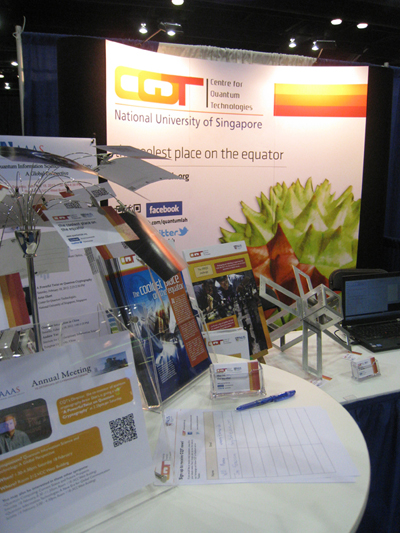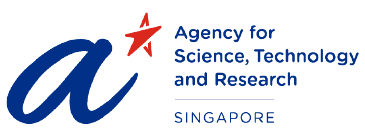Highlights
CQT participates in global science event

Thousands of delegates attended the 2012 AAAS Annual Meeting held in the waterfront convention centre in Vancouver, Canada.
CQT participated 16-20 February in one of the world's most significant gatherings in science — the Annual Meeting of the American Association for the Advancement of Science (AAAS). The interdisciplinary meeting attracts a global group of leading scientists, policy-makers and the media, as well as many members of the public.
CQT Director Artur Ekert gave an invited talk in the symposium "Quantum Information Science and Technology: A Global Perspective". CQT was also proud to represent quantum research and Singapore in the meeting's exhibition hall. The 2012 AAAS Annual Meeting was held in Vancouver, Canada, and was attended by thousands of people.
A story in The Economist about quantum cryptography, reported from the meeting, features both Artur and CQT's ambitions to send a quantum entanglement experiment into space, a project CQT showcased at its exhibition stand (read more below). Media including LiveScience, PhysOrg and ScienceCodex reported on the new results Artur presented. See also the account of CQT's involvement in the meeting on the NUS newshub.
CQT Director presents new research
In his talk "A Powerful Twist on Quantum Cryptography", Artur presented the history of cryptography from the techniques used to send secret messages in ancient Rome to his and his colleagues' most recent work on quantum cryptography. Artur was the first to describe a protocol for cryptography that exploits the property of quantum entanglement.
Until now, quantum cryptography protocols have always assumed that an adversary would not have access to information about any choices that are made during the process of encryption. "We are challenging this assumption," says Artur. "We are asking well, what if you are controlled?" It is the ultimate paranoid scenario, when either the equipment or the operator is in the control of a malicious power.
The surprising result is that quantum cryptography can still sometimes triumph. A preprint is available (arXiv:1202.3571) and a popular description was prepared for media at the AAAS meeting.
The new work was led by Dax Koh, a scholar with Singapore's Agency for Science, Technology and Research (A*STAR) working at CQT, and Michael Hall of the Centre for Quantum Dynamics at Griffith University in Australia. Others involved in addition to Ekert are Valerio Scarani of CQT and NUS, Setiawan of NUS, Alastair Kay of CQT and the University of Oxford, and James Pope and Chiara Marletto of the University of Oxford.
The symposium offered, in addition to the talk by Artur, presentations by quantum scientists leading research centres in Canada, Germany, China and the United States. It drew an audience that filled the allocated room and had people standing at the back. CQT thanks Charles Clark from the Joint Quantum Institute in the United States and Amy Wang from the Institute for Interdisciplinary Information Sciences in Beijing, China, for co-organizing the session.

CQT's stand in the AAAS exhibition hall offered literature and showcased a project to put a quantum experiment onto a satellite. Drawing meeting participants and families attending the family science day, the stand was busy over the three-day exhibition. See more photos.
The coolest place on the equator on show
In the exhibition hall, CQT showcased a CQT initiative to send a quantum entanglement experiment into space. An entanglement experiment would typically fill a room with lasers, lenses, mirrors and electronics. A team led by CQT Principal Investigator Alexander Ling is redesigning and rebuilding the big and delicate equipment to fit into a 3x10x10cm slice of a tiny satellite.
The experiment could launch as early as 2013 on a "CubeSat" designed by collaborators at Nanyang Technological University. Creating entangled photon pairs on a satellite will not only be a check of fundamental physics but also a first step towards imagining future global quantum communication networks.
Members of Alex's group William Morong and Tan Yue Chuan demonstrated at the meeting some of the technology the group has developed. The stand was also staffed by CQT outreach team members Evon Tan and Jenny Hogan. See some photos on CQT's Facebook page.
Also exhibiting at the 2012 AAAS Annual Meeting were friends of CQT the Institute for Quantum Computing at the University of Waterloo, Canada and Singapore's Nanyang Technological University (NTU). CQT is hosted by the National University of Singapore (NUS) but also partners with NTU in supporting some experimental laboratories on the NTU campus.
The CQT stand offered literature about CQT and NUS. The literature included a set of CQT postcards highlighting different aspects of the Centre's life and research. Hundreds were distributed to meeting delegates. One of the most popular cards was designed to pay tribute to CQT's home country. The card shows a durian fruit, with the shape of Singapore island mapped in red. The same image appeared on the CQT stand's eye-catching backdrop.






